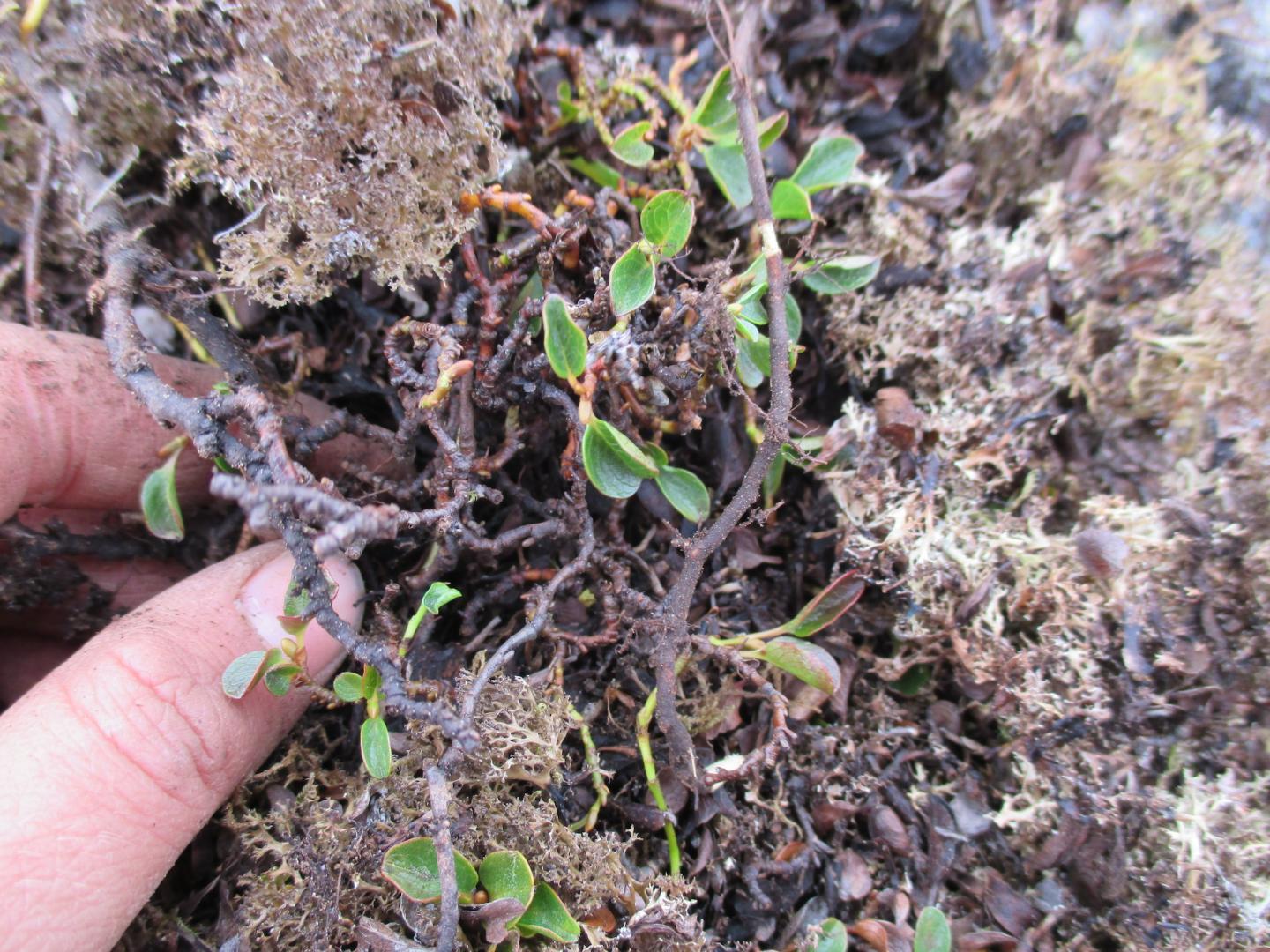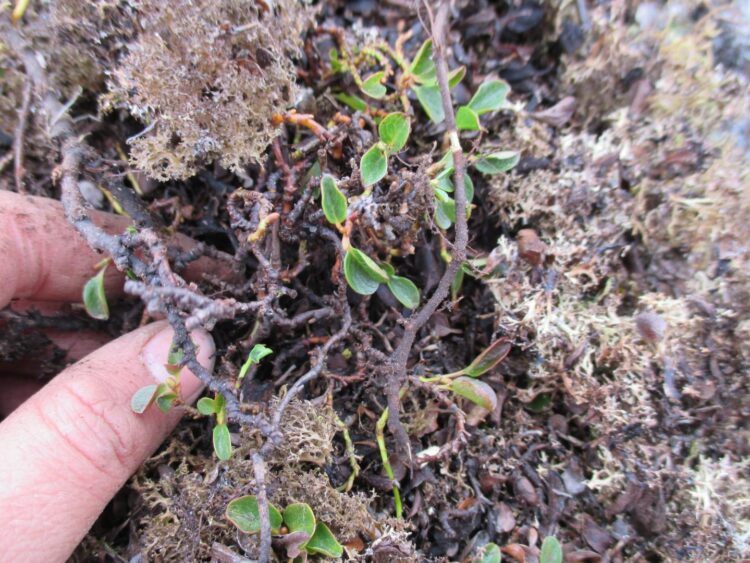Counting tiny rings showed synchronous growth across an entire arctic archipelago

Credit: Lisa Sandal, NTNU
The polar willow (Salix polaris) may not seem like much when you look at it — just a jumble of tiny green leaves in a dense mat that pokes out of the tundra.
But beyond its humble appearance, this little shrub plays an outsized role when it comes to the creatures living in the Arctic archipelago of Svalbard.
It’s not just that Svalbard’s reindeer depend on it for food. It’s also that how it grows reflects what happens with the growth of all other plants across the whole of Svalbard.
Now, researchers have found that the polar willow and other plants grow in synchrony across Svalbard, in direct response to July temperatures.
Mathilde Le Moullec, a postdoc at the Norwegian University of Science and Technology’s (NTNU) Centre for Biodiversity Dynamics, has spent much of her academic career investigating all of the interlocking puzzle pieces that make the Svalbard plant and animal community work.
She’s searched for reindeer for four summers as a way to get a highly accurate population estimate for the animals. She’s hunted for old reindeer antlers and bones during those years, so she could carbon date them.
All of that information combined allowed her to see where on Svalbard the animals formerly lived, and how their populations had changed over time. She used all this information to document how Svalbard’s reindeer population rebounded after being hunted down to very low numbers for centuries.
But Le Moullec realized she needed to look beyond just reindeer to have a deeper understanding of the whole ecosystem.
“Salix is an important part of their main diet, especially because there is almost no lichen on Svalbard,” she said. One study found that lichen makes up just 2 per cent of the diets of Svalbard reindeer, she said.
By studying what controls the growth of the polar willow across Svalbard, “you can also see how climate is affecting primary production in different places,” meaning growth of things like plants, which are at the base of the food chain, she said. “It also gives you a window on what different reindeer populations have to eat.”
Another advantage of studying something like the polar willow is that “you can go to one place, one time, dig up a willow, and come back with 40 years or more of data,” she said.
So that’s what she did. In 2015, when two friends offered the use of their sailboat Sillage to help her reach some of Svalbard’s more remote locations to count reindeer, she and her friend Morgen Bender, a PhD candidate from UiT — The Arctic University of Norway also set about digging up polar willows.
Thirty of their plants came from Semmeldalen, in south central Svalbard. The advantage of Semmeldalen was that René van der Wal, a professor at the University of Aberdeen and Swedish University of Agricultural Sciences, who worked with Le Moullec on other willow research, had established a long-term study of plants there starting in 1998.
But that was only the beginning.
Because then she and colleague Lisa Sandal, then a master’s student in the Department of Biology, had to count the microscopic growth rings in this miniature arctic shrub.
Even though some of the willows being studied were more than 40 years old — the oldest was 70 — the growth rings were teeny-tiny.
“The entire root is the thickness of the tip of a fork, it is just a few millimetres across,” Le Moullec said. “Each growth ring is just a few micrometres, so we cut cross sections that are a cell thickness of two micrometres.”
To put that in perspective, a strand of spider’s web silk is 3-8 micrometres in diameter.
The researchers also had to look at multiple cross sections from each plant.
That’s because some shrubs might not put on growth rings every year. Or the cross section might only have partial growth rings on one side that the researchers might not see, depending on where in the plant the cross section came from.
They put the cross sections under a powerful microscope and took photographs — as many as 70 for a cross section — so they could merge the pictures together to make a single stunningly beautiful photo with a great amount of detail.
“The lab part took almost two years,” Le Moullec said. “One person couldn’t do it alone. And with Lisa, we joked the whole time, if this research never becomes science, we can sell it as art. “
In fact, one of the images won the British Ecological Society’s 2018 Capturing Ecology photo competition in the Art of Ecology category.
“Fortunately, the art also became science!” Le Moullec said.
The shrub rings show distinctive patterns, year by year, based on how good or poor the growing conditions were. But the researchers wanted to know if one particular weather factor was more important than others in determining how well the plants would grow.
Certain years, called pointer years, are very good growth years for all plants. That makes the pointer year rings easy to find, making them like a time stamp in the rings of each willow. Using the pointer years enabled the researchers to figure out if some willows were missing growth years, or if the cross section they had might have had a ring that grew on only one side.
They needed to know this to know the year of formation for each growth ring for each shrub.
From there it was a matter of looking at weather data across Svalbard, and looking at five different weather-related factors to see which were best reflected in tree ring growth.
These factors were the onset of spring, amount of snowfall, rain-on-snow events, summer temperature and summer precipitation.
Of all these factors, July temperature was the most important for willows growing in all 8 sites. Yes, across a huge archipelago, July temperatures ruled for willow — and had an effect for all other vegetation there, causing vegetation to grow in lock-step. That also has significance for grazing animals, like reindeer.
Researchers have seen this kind of synchronous pattern before, in boreal or temperate forests, where summer temperatures have a coordinating effect on tree growth across large areas. But this is the first time this kind of research has been done in the Arctic, Le Moullec said, and in a tree where the largest structure — the root — is half the size of your pinkie finger.
Le Moullec and her colleagues did find another factor that negatively affected willow growth in some areas, and that was rain-on-snow events. These are exactly what they sound like — a weather event where rain falls on snow, and then the plants become covered in a thick layer of ice which seals them away from the air and essentially smothers them until the ice melts away.
In earlier research, Le Moullec’s supervisor, Brage Bremset Hansen, documented how rain-on-snow events could cause widespread problems for reindeer populations, ultimately causing a ripple effect for the other species that overwinter on Svalbard.
Researchers expect more rain-on-snow events on Svalbard as increasing climate change causes arctic temperatures to skyrocket.
As a result, the relative importance of seasons for growth patterns may change, Le Moullec said. Because the effect of rain-on-snow was so different in different parts of Svalbard, the synchronizing effect of July temperature on vegetation growth may be weakened over time, she said.
On one hand, that could be better for the overall health of the ecosystem, because when one area has a bad growth year, other areas may do fine. As a consequence, even though reindeer in areas with poor growth may have a hard time surviving, not all reindeer populations on the island will be equally affected.
On the other hand, if rain-on-snow become widespread all across Svalbard, all populations may have a hard time simultaneously.
Van der Wal, who has worked with Le Moullec although not on this study, said he was impressed by her “painstaking but elegant work.”
“We knew that warm summers allowed high arctic plants to grow well, but always believed that this was what happened above ground. For Mathilde to show that good years above ground also means good growth below ground, and for this to reflect the productivity of all higher plants together is a major step forward,” he said.
###
Reference: Le Moullec, M., Sandal, L., Grøtan, V., Buchwal, A. and Hansen, B.B. (2020), Climate synchronises shrub growth across a high arctic archipelago: contrasting implications of summer and winter warming. Oikos. doi:10.1111/oik.07059
Media Contact
Mathilde Le Moullec
[email protected]
Original Source
https:/
Related Journal Article
http://dx.






